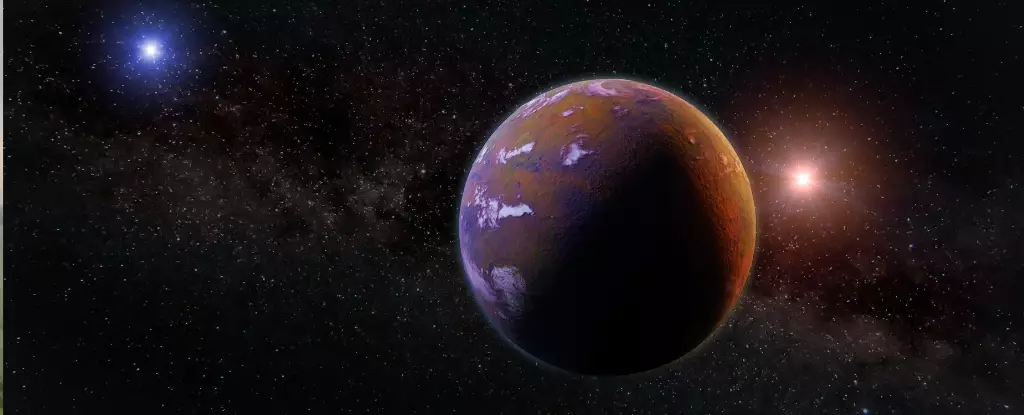The universe continues to surprise astronomers with its complex processes and hidden wonders. Among the most compelling revelations in recent years is the direct imaging of young planets forming around distant stars. Traditionally, planet formation has been a subject shrouded in mystery, primarily because the environments in which planets develop are often cloaked in thick dust and gas clouds, making direct observation challenging. However, cutting-edge technology and recent studies are shifting the paradigm, offering unprecedented glimpses into these cosmic nurseries. The discovery of a young giant planet orbiting a star that has already shed its protoplanetary disk exemplifies this breakthrough, challenging long-held assumptions and opening new avenues for understanding planetary genesis.
This discovery underscores that planet formation is a highly dynamic and heterogeneous process. It suggests that different stars, even within the same binary system, can have vastly different evolutionary timelines and mechanisms. Such insights compel us to rethink the universality and timescales of planet formation—a topic that has traditionally been approached with caution and conservative models. The excitement surrounding this ground-breaking detection is rooted in its implications: it not only provides direct evidence supporting theories that planets form close to the star’s snow line but also points to a more nuanced picture where stellar environments evolve at different rates, influencing the planetary building blocks around them.
The Significance of a Dust-Free Observatory Window
One of the most intriguing aspects of this discovery is the fact that the star housing the newly imaged planet has already cleared its remaining protoplanetary disk of dust. In earlier studies, the dense dust shrouds posed significant barriers to observing nascent planets because the material blocks visible and near-infrared light—traditional windows for direct imaging. The removal of obscuring dust around the primary star serves as a natural clearing, revealing a pristine environment for exoplanet detection.
This phenomenon is particularly compelling because it illustrates the importance of stellar maturity and disk dissipation in exoplanet observation strategies. While younger stars often feature active, dusty disks rife with planet-forming activity, they simultaneously hamper direct observational efforts. Conversely, stars that have cleared their disks, despite being less dynamic, become ideal targets for direct imaging of orbiting planets. Such stars act as cosmic flashlights, illuminating planets that would otherwise remain hidden.
Furthermore, this case demonstrates that planet formation might continue or conclude regardless of the presence of substantial circumstellar dust. The primary star, although devoid of its original disk, still hosts a relatively young planet, hinting that planet formation can be a relatively rapid process, occurring within the initial dozen million years of a star’s life. This insight could recalibrate current models of planetary evolution, emphasizing that the absence of a disk does not equate to a lack of planetary structures or ongoing formation.
Refining Detection Techniques: The Power of Precision and Patience
Detection of exoplanets, especially those forming in close proximity to their stars, remains one of the most technically demanding feats in astronomy. The recent discovery emphasizes how meticulous observation, combined with advancements in instrumentation, can yield remarkable results. Tools like the Very Large Telescope (VLT) and its SPHERE instrument exemplify how multi-year dedication, coupled with technological excellence, can distinguish a faint planetary signal from overwhelming stellar glare.
The process was akin to cosmic patience—taking four years of persistent, high-precision measurements. The researchers had to coordinate multiple observations, ensuring that the planetary candidate’s movement was consistent with orbital motion rather than a background star. This process is critical for confirming that the detected object is a bound planet and not an unrelated star or artifact. The reliance on Gaia astrometric data further strengthens this approach by providing accurate positional data that helps disentangle true planetary signals from background noise.
The challenge, however, is substantial. Exoplanets at smaller separations—less than 30 astronomical units—are difficult to image directly because of the bright stellar background and the small angular separation. Yet, this discovery illustrates that with patience, precision, and optimized instrumentation, what once seemed impossible is now within reach. It also highlights the importance of luck—being observant at the right moment in the planet’s orbit can make or break a detection campaign.
The Broader Impact and Future Horizons
This discovery is more than a solitary achievement; it signals a new chapter in the search for and study of young nebulous planets. The rarity of detecting giant planets at closer orbits (around 20 au or less) has limited our understanding of their formation and prevalence. However, as surveys become more sophisticated and datasets—such as Gaia’s upcoming releases—are integrated, the prospects for identifying similar planets grow brighter.
The implications extend beyond mere detection. These young planets serve as natural laboratories to study the processes involved in planetary accretion, migration, and atmospheric development. By examining planets like HD 135344 Ab—a roughly 10 Jupiter-mass world—you gain crucial insights into how massive planets assemble and evolve within their initial lifespans of under 12 million years.
Looking ahead, the advent of next-generation telescopes, especially the Extremely Large Telescope (ELT) set to commence observations by 2029, promises to revolutionize this field even further. With their unparalleled imaging resolution and sensitivity, astronomers will be able to scrutinize exoplanet atmospheres, compositions, and perhaps even signs of potential habitability. This blend of technological evolution and strategic observation will unearth many more young, dynamically intriguing planets, fundamentally enriching our understanding of the universe’s planetary diversity.
Ultimately, such discoveries demonstrate that the universe is far more inventive and intricate than previously imagined. Each new find challenges the boundaries of our models and compels us to develop more comprehensive theories about how worlds come into being. As technology advances, so too does our capacity to unveil the universe’s most closely guarded secrets—turning what was once speculative theory into observable, tangible cosmic truths.


Leave a Reply